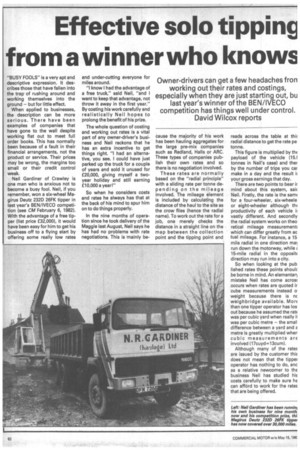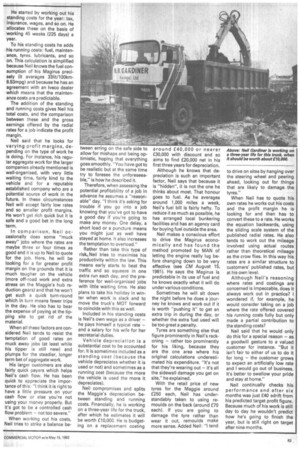Effective solo tipping from a winner who knows
Page 54

Page 57

If you've noticed an error in this article please click here to report it so we can fix it.
"BUSY FOOLS" is a very apt and descriptive expression. It describes those that have fallen into the trap • of rushing around and working themselves into the ground — but for little effect.
When applied to businesses, the description can be more serious. There have been examples of companies that have gone to the wall despite working flat out to meet full order books. This has normally been because of a fault in their financial arrangements, not the product or service. Their prices may be wrong, the margins too small or their credit control weak.
Neil Gardiner of Crawley is one man who is anxious not to become a busy fool. Neil, if you remember, won a six-wheel Magirus Deutz 232D 26FK tipper in last year's BEN/IVECO competition (see CM February 6, 1982). With the advantage of a free tipper (list price £32,000), it would have been easy for him to get his business off to a flying start by offering some really low rates and under-cutting everyone for miles around.
"I know I had the advantage of a free truck," said Neil, "and I want to keep that advantage, not throw it away in the first year." By costing his work carefully and realistically Neil hopes to prolong the benefit of his prize.
The whole question of costing and working out rates is a vital part of any owner-driver's business and Neil reckons that he has an extra incentive to get things right. "I had an alternative, you see. I could have just parked up the truck for a couple of years and sold it unused for £20,000, giving myself a twoyear holiday and still earning £10,000 a year!"
So when he considers costs and rates he always has that at the back of his mind to spur him on to do things properly.
In the nine months of operation since he took delivery of the Maggie last August, Neil says he has had no problems with rate negotiations. This is mainly be
cause the majority of his work has been hauling aggregates for the large pre-mix companies such as Redland, Halls or ARC. These types of companies publish their own rates and so there is no negotiation involved.
These rates are normally based on the "radial principle" with a sliding rate per tonne depending on the mileage involved. The mileage element is included by calculating the distance of the haul to the site as the crow flies (hence the radial name). To work out the rate for a job, one merely checks the distance in a straight line on the map between the collection point and the tipping point and reads across the table at thir radial distance to get the rate pe tonne.
This figure is multiplied by the payload of the vehicle (15.l tonnes in Neil's case) and ther by the number of trips you car make in a day and the result your gross earnings that day.
There are two points to bear ir mind about this system, sak Neil. Firstly, the rate is the sem( for a four-wheeler, six-wheele or eight-wheeler although thr productivity of each vehicle vastly different. And secondly the radial system works on theo retical mileage measurement; which can differ greatly from ac tual mileage. For instance, a 15 mile radial in one direction ma) run down the motorway, while i• 15-mile radial in the opposite direction may run into a city.
So when looking at the pub fished rates these points shoulc be borne in mind. An elementan mistake Neil has come acrosr occurs when rates are quoted ir cube measurements instead o weight because there is nc weighbridge available. More than one tipper operator has los out because he assumed the rate was per cubic yard when really ii was per cubic metre — the small difference between a yard and a metre is greatly multiplied when cubic measurements arc involved (17cuyd=13cum).
Although many of the ratec are issued by the customer this does not mean that the tipper operator has nothing to do, anc as a relative newcomer to the business Neil has studied his costs carefully to make sure hE can afford to work for the rates that are being offered. He started by working out his standing costs for the year: tax, insurance, wages, and so on. He allocates these on the basis of working 45 weeks (225 days) a year.
To his standing costs he adds his running costs: fuel, maintenance, tyres. lubricants, and so on. This calculation is simplified because Neil knows the fuel consumption of his Magirus precisely (it averages 331it/100km8.53rnpg) and because he has an agreement with an Ivaco dealer which means that the maintenance costs are predictable.
The addition of the standing and running costs gives Neil his total costs, and the comparison between these and the gross earnings offered by the radial rates for a job indicate the profit margin.
Neil said that he looks for varying profit margins, depending on the type of work he is doing. For instance, his regular aggregate work for the larger companies already mentioned is well-organised, with very little waiting time, fairly kind to the vehicle and for a reputable established company who are a potential source of work in the future. In these circumstances Neil will accept fairly low rates and so smaller profit margins. He won't get rich quick but it is safe and a good bet in the long term.
In comparison, Neil occasionally does some "muck away" jobs where the rates are maybe three or four times as good and it is up to Neil to quote for the job. Here, he will be looking for a far greater profit margin on the grounds that it is much tougher on the vehicle (more off-road work and extra stress on the Maggie's hub reduction gears) and that he won't get such a quick turn-round which in turn means fewer trips in the day. He also has to bear the expense of paying at the tipping site to get rid of the material.
When all these factors are considered Neil tends to resist the temptation of good rates on muck away jobs (at least while his tipper is still new) and plumps for the steadier, longer term bet of aggregate work.
His larger customers are also fairly quick payers which helps Neil's cash flow. He has been quick to appreciate the importance of this: "I think it is right to have a little pressure on your cash flow or else you're not using your money properly. But it's got to be a controlled cash flow problem — not too severe."
When working out his costs, Neil tries to strike a balance be
tween erring on the safe side to allow for mishaps and being optimistic, hoping that everything goes smoothly. "You have got to be realistic but at the same time try to foresee the unforeseeable," is how he described it.
Therefore, when assessing the potential profitability of a job in advance he assumes a "reasonable" day. "I think it's asking for trouble if you go into a job knowing that you've got to have a good day if you're going to make any money. One delay, a short load or a puncture means you might just as well have stayed at home. It also increases the temptation to overload."
Rather than take this type of risk,Neil tries to maximise his productivity within the law. This means early starts to beat the traffic and so squeeze in one extra run each day, and the preference for well-organised jobs with little waiting time. He also plans to take his holiday in winter when work is slack and to move the truck's MOT forward to coincide with this as well.
Included in his standing costs is Neil's own wage as a driver, — he pays himself a typical rate — and a salary for his wife for her secretarial duties.
Vehicle depreciation is a substantial cost to be accounted for. It is sometimes included as a standing cost (because the vehicle depreciates whether it is used or not) and sometimes as a running cost (because the more the vehicle is used the more it depreciates).
Neil compromises and splits the Maggie's depreciation between standing and running costs. Financially, he is working on a three-year life for the truck, after which he estimates it will be worth £10,000. He is budgeting on a replacement costing
around £4 0,0 00 or nearer £30,000 with discount and so aims to find £20,000 net in his first three years for depreciation.
Although he knows that depreciation is such an important factor, Neil says that because it is "hidden", it is not the one he thinks about most. That honour goes to fuel. As he averages around 1,000 miles a week, Neil's fuel bill is fairly hefty. To reduce it as much as possible, he has arranged local bunkering facilities and has an agency card for buying fuel outside the area.
Neil makes a conscious effort to drive the Magirus economically and has found the method promoted by MAN of letting the engine really lug before changing down to be very effective (see CM August 15, 1981). He says the Magirus is predictable in its use of fuel and he knows exactly what it will do under various conditions.
Sometimes he will sit down the night before he does a journey he knows and work out if it is worth "pushing it" to get an extra trip in during the day, or whether the extra fuel used will be too great a penalty.
Tyres are something else that figure prominently in Neil's reckoning — rather too prominently for his liking, because they are the one area where his original calculations underestimated his expenditure. "It's not that they're wearing out — it's all the sidewall damage you get on site," he explained.
With the retail price of new tyres for the Maggie around £250 each, Neil has understandably taken to using remoulds on the back (around £70 each). If you are going to damage the tyre rather than wear it out, remoulds make more sense. Added Neil: "I tend to drive on sites by hanging over the steering wheel and peering ahead, looking out for things that are likely to damage the tyres."
When Neil has to quote his own rates he works out his costs and the profit margin he is looking for and then has to convert these to a rate. He works the equation backwards, using the sliding scale system of the published radial rates. He also tends to work out the mileage involved using actual routes rather than theoretical mileage as the crow flies. In this way his rates are a similar structure to customers' published rates, but at his own level.
Although Neil's reasoning where rates and costings are concerned is impeccable, does it always work out in practice? I wondered if, for example, he would consider taking on a job where the rate offered covered his running costs fully but only made a partial contribution to the standing costs?
Neil said that he would only do this for a special reason — as a goodwill gesture to a valued customer for instance. "But it isn't fair to either of us to do it for long — the customer grows to expect an artificially low rate and I would go out of business. It's better to swallow your pride and stay at home."
Neil continually checks his performance and after six months was just £40 adrift from his predicted target profit figure. Because much of his work is still day to day he wouldn't predict how he's going to finish the year, but is still right on target after nine months.
















































































